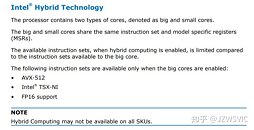- Joined
- Oct 9, 2007
- Messages
- 47,598 (7.45/day)
- Location
- Dublin, Ireland
| System Name | RBMK-1000 |
|---|---|
| Processor | AMD Ryzen 7 5700G |
| Motherboard | Gigabyte B550 AORUS Elite V2 |
| Cooling | DeepCool Gammax L240 V2 |
| Memory | 2x 16GB DDR4-3200 |
| Video Card(s) | Galax RTX 4070 Ti EX |
| Storage | Samsung 990 1TB |
| Display(s) | BenQ 1440p 60 Hz 27-inch |
| Case | Corsair Carbide 100R |
| Audio Device(s) | ASUS SupremeFX S1220A |
| Power Supply | Cooler Master MWE Gold 650W |
| Mouse | ASUS ROG Strix Impact |
| Keyboard | Gamdias Hermes E2 |
| Software | Windows 11 Pro |
Intel's 12th Gen Core "Alder Lake-S" desktop processors in the LGA1700 package could see the desktop debut of Intel's Hybrid Technology that it introduced with the mobile segment "Lakefield" processor. Analogous to Arm big.LITTLE, Intel Hybrid Technology is a multi-core processor topology that sees the combination of high-performance CPU cores with smaller high-efficiency cores that keep the PC ticking through the vast majority of the time/tasks when the high-performance cores aren't needed and hence power-gated. The high-performance cores are woken up only as needed. "Lakefield" combines one "Sunny Cove" high-performance core with four "Tremont" low-power cores. "Alder Lake-S" will take this concept further.
According to Intel slides leaked to the web by HXL (aka @9550pro), the 10 nm-class "Alder Lake-S" silicon will physically feature 8 "Golden Cove" high-performance cores, and 8 "Gracemont" low-power cores, along with a Gen12 iGPU that comes in three tiers - GT0 (iGPU disabled), GT1 (some execution units disabled), and GT2 (all execution units enabled). In its top trim with 125 W TDP, "Alder Lake-S" will be a "16-core" processor with 8 each of "Golden Cove" and "Gracemont" cores enabled. There will be 80 W TDP models with the same 8+8 core configuration, which are probably "locked" parts. Lastly, there the lower wrungs of the product stack will completely lack "small" cores, and be 6+0, with only high-performance cores. A recurring theme with all parts is the GT1 trim of the Gen12 iGPU.

Intel is innovating a way to reconcile the vast feature-set and ISA differences between its "big" and "small" cores. The big "Golden Cove" core supports certain AVX-512 instructions, besides TSX-NI (tensor operations, matrix multiplication), and FP16 (half precision floating point). The smaller "Gracemont" core lacks these instruction sets. So whenever the OS sends traffic that requires these instructions, the processor will be forced to wake up a "Golden Cove" core, and additional such cores as needed.
A quick reminder of the LGA1700 socket - this platform could see Intel introducing PCI-Express 5.0 I/O. There's also a possibility of DDR5 unbuffered memory support. The significant increase in pin-count for the mainstream-desktop segment is probably attributable to a Ryzen-like nucleation of platform I/O over from the PCH to the CPU socket, along with more CPU-attached PCIe lanes.
View at TechPowerUp Main Site
According to Intel slides leaked to the web by HXL (aka @9550pro), the 10 nm-class "Alder Lake-S" silicon will physically feature 8 "Golden Cove" high-performance cores, and 8 "Gracemont" low-power cores, along with a Gen12 iGPU that comes in three tiers - GT0 (iGPU disabled), GT1 (some execution units disabled), and GT2 (all execution units enabled). In its top trim with 125 W TDP, "Alder Lake-S" will be a "16-core" processor with 8 each of "Golden Cove" and "Gracemont" cores enabled. There will be 80 W TDP models with the same 8+8 core configuration, which are probably "locked" parts. Lastly, there the lower wrungs of the product stack will completely lack "small" cores, and be 6+0, with only high-performance cores. A recurring theme with all parts is the GT1 trim of the Gen12 iGPU.

Intel is innovating a way to reconcile the vast feature-set and ISA differences between its "big" and "small" cores. The big "Golden Cove" core supports certain AVX-512 instructions, besides TSX-NI (tensor operations, matrix multiplication), and FP16 (half precision floating point). The smaller "Gracemont" core lacks these instruction sets. So whenever the OS sends traffic that requires these instructions, the processor will be forced to wake up a "Golden Cove" core, and additional such cores as needed.
A quick reminder of the LGA1700 socket - this platform could see Intel introducing PCI-Express 5.0 I/O. There's also a possibility of DDR5 unbuffered memory support. The significant increase in pin-count for the mainstream-desktop segment is probably attributable to a Ryzen-like nucleation of platform I/O over from the PCH to the CPU socket, along with more CPU-attached PCIe lanes.
View at TechPowerUp Main Site





